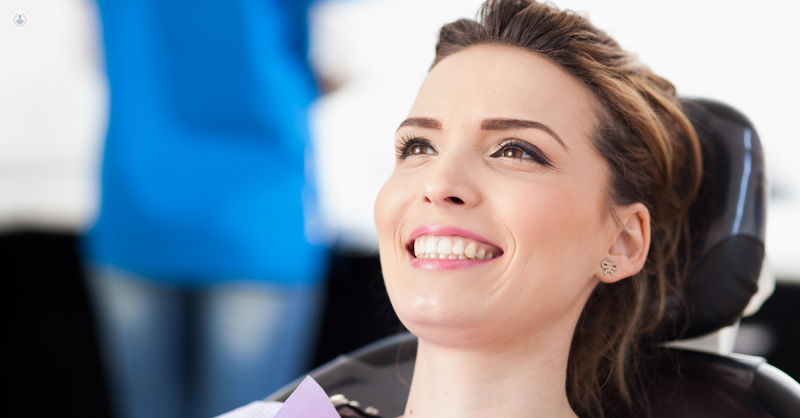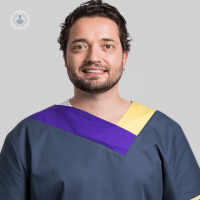The benefits of intraoral scanners in orthodontics
Written by:New technology is undoubtedly changing how the medical world works, assisting diagnoses and making it easier to predict the right course of treatment for patients. New technology also has a major role to play in orthodontics. We decided to ask Dr Laurence Masters about how the 3Shape TRIOS® scanner has helped him at his clinic.

What difference has the 3Shape TRIOS® done for your practice?
Happier patients
Patient comfort is paramount and scans provide a much more comfortable, tolerable and faster approach than the traditional use of impressions. There are no gag reflexes or unpleasant smells or tastes from physical impressions that a lot of children, in particular, complain about. Also, patients don’t have to worry about feeling suffocated.
The scan also gives patients peace of mind, by allowing them to see what their teeth could look like (virtually) before they even begin their treatment.
Lower costs and less storage space needed
Rather than using plaster models, PVS or alginate, all patients at the clinic are now scanned with this new technology to obtain an initial model of their teeth before they begin their treatment. This saves storage space as there are no physical impressions that need to be physically stored and costs are lowered because impression materials don’t have to be shipped.
Diagnosis and treatment is made easier
3Shape Orthoanalyzer® software can be used to diagnose patients and execute a treatment plan. Dental procedures can be tried and practised virtually, before carrying out an irreversible dental procedure. Teeth can be moved around and dental extractions simulated. The patient can have a visual representation of what their teeth could look like before they ever have treatment.
Indirect bonding is easier, faster and more precise
In the past, braces were placed directly onto stone models to make the transfer jigs that would be directly placed onto the patient’s teeth. Although the braces were accurate, this method was time-consuming and impractical.
Digital indirect bonding is much quicker, easier to use and more precise. Patients are scanned with the 3Shape TRIOS®, braces can be placed virtually with Orthoanalyzer® before the transfer jigs are made and directly printed with a 3D printer.
Splints are made easier
Before, during and after orthodontic treatment, it’s important to have healthy and stable temporomandibular joints. Scans can detect problems before braces are made and attached to the patient’s teeth. Splints can be designed and printed in 3D, just like indirect bonding trays are made.
TRIOS® can send information to Invisalign®
Dr Masters’s clinic offers a variety of treatments including Invisalign and lingual braces. 3Shape TRIOS® is the only external scanner that can directly send stl. files to Invisalign so it’s very beneficial for every patient undergoing Invisalign®.
More effective communication with labs
Scanning with TRIOS® allows stl. files to be sent directly to the lab. This means communication is faster, easier and more efficient. If there are any problems or doubts in the process of making braces, for example, they can be communicated and solved right away. There is also less turn around with the time it takes for appliances to be made.
Better communication with interdisciplinary teams
Many patients require an interdisciplinary team to treat their case. Along with an orthodontist, they may need a restorative or maxillofacial surgeon. New technology like the TRIOS® scanner allows everyone to communicate better, exchange ideas and execute a plan.
Mid treatment records can be analysed easily
In the world of orthodontics, it’s often necessary to take a step back and analyse the progress of patients. Mid treatment records are often needed to make sure treatment is going as planned. TRIOS® can easily scan patients, even those with brackets, to make sure their treatment is on the right track.
Retainers can be made in a shorter space of time
A major advantage of TRIOS® is that both jaws can be scanned while brackets are still on the teeth and results can be sent to the lab to design and make the patient’s retainers. Orthoanalyzer® allows orthodontists to virtually remove the brackets and have the retainers ready on the day that the brackets are removed.
There is less risk of teeth relapsing as the orthodontist doesn’t have to wait for the patient to return after the appliance has been removed. The less time in between taking out the brackets and receiving the retainers, the better the outcome. Also, if a patient breaks or loses a retainer, with this new technology, a new retainer can be created and sent to the patient almost immediately, without the need for a new scan.
New digital technology such as the TRIOS 3Shape® scanner has brought many exciting changes into the world of orthodontics in the last few years. Dr Masters sees the TRIOS 3Shape® scanner “as a contemporary technological breakthrough that provides a better and more comfortable experience” for both his team and his patients.
Although traditional impression-taking techniques have proven to be accurate, they can be uncomfortable for patients. The speed and accuracy of new technology allow for greater precision and less error. Also, it improves communication between clinicians and labs. In a recent poll at the clinic, 100% of Dr Master’s patients preferred digital scanning to traditional methods.
Would you like to make an appointment with Dr Masters? Click here to view his availability.


